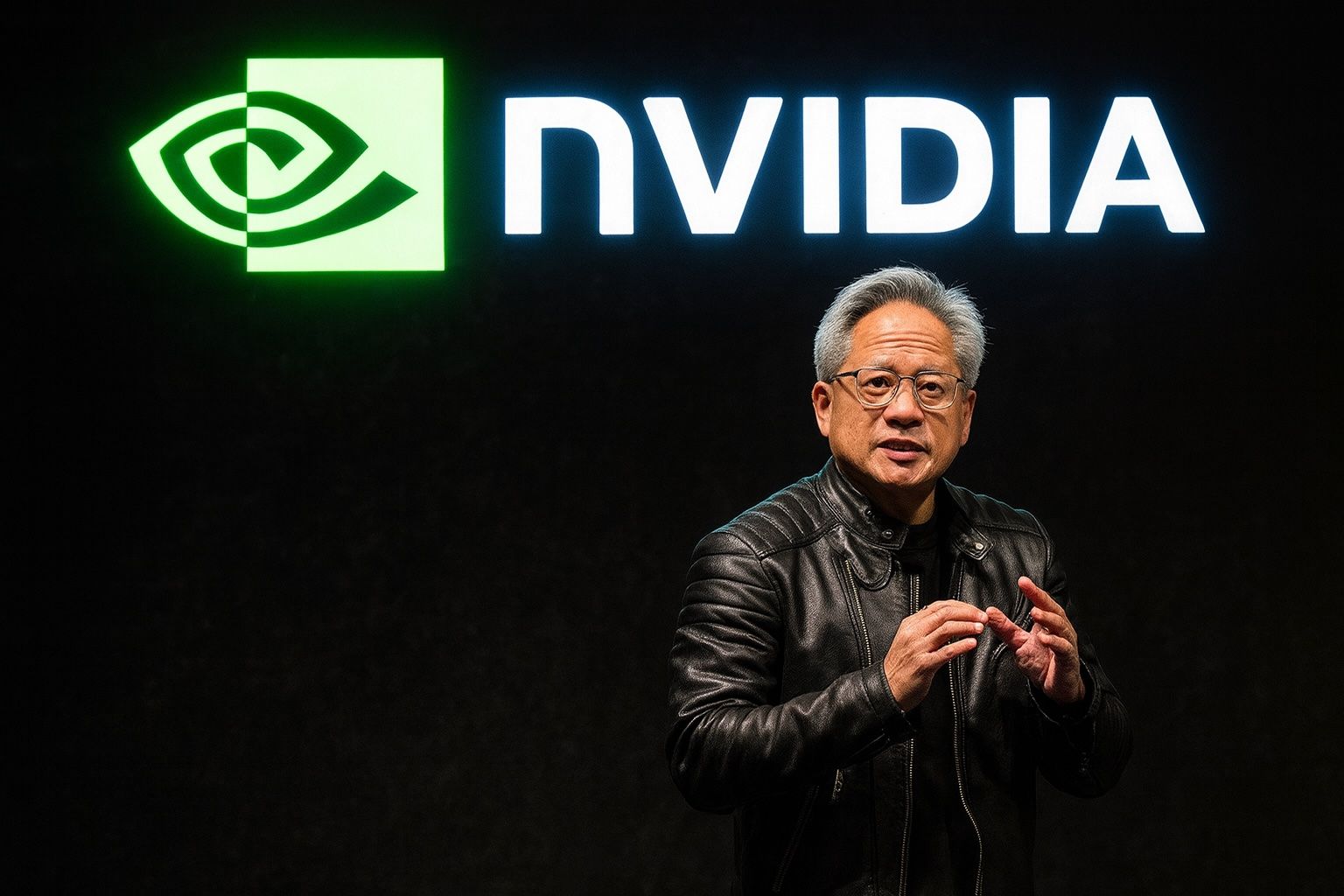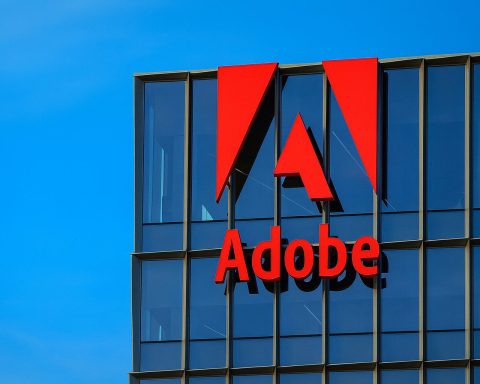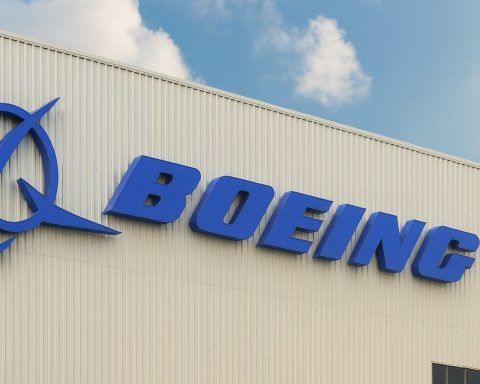Published: November 19, 2025
Nvidia has once again rewritten the record books.
On Wednesday, the AI chip leader reported third-quarter fiscal 2026 results that smashed Wall Street expectations, powered by soaring demand for its data center GPUs used to train and run artificial intelligence models. Revenue hit a record $57.0 billion, up 22% quarter over quarter and 62% year over year, with profit and guidance both coming in ahead of forecasts. [1]
After the report, Nvidia shares jumped in after-hours trading, adding to a rally into the close as investors cheered another blowout AI quarter. [2]
Key Numbers From Nvidia’s Q3 FY2026
For the fiscal quarter ended October 26, 2025, Nvidia delivered: [3]
- Revenue: $57.0 billion
- +22% vs. Q2 FY2026
- +62% vs. Q3 FY2025
- GAAP and non‑GAAP gross margin: 73.4% and 73.6%
- GAAP net income: $31.91 billion
- Diluted EPS (GAAP and non‑GAAP): $1.30, up around 60–67% year over year
- Operating income (GAAP): $36.0 billion
- Shareholder returns: $37.0 billion returned in the first nine months of FY26 via buybacks and dividends, with $62.2 billion still authorized for repurchases. [4]
On top of that, Nvidia’s board approved a $0.01 quarterly cash dividend payable on December 26, 2025 to shareholders of record on December 4, 2025. [5]
Nvidia Crushes Expectations – Again
Wall Street was already expecting a massive quarter. Analysts had been looking for roughly $54.6–$55.0 billion in revenue and about $1.23–$1.26 in EPS. [6]
Instead, Nvidia delivered:
- Revenue: $57.0 billion vs. ~$54.6–$55.0 billion expected
- EPS: $1.30 vs. ~$1.23–$1.26 expected
Kiplinger’s live earnings coverage noted that the company not only exceeded headline estimates but also issued much stronger‑than‑expected guidance for the fourth quarter, which helped push NVDA shares up nearly 4% in after-hours trading. [7]
Before the release, options markets were pricing in a big move: TipRanks’ data suggested traders were bracing for roughly a 7.7% swing in either direction once Q3 numbers hit. [8]
So far, the numbers are validating those expectations — and, crucially for the broader market, continue to push back against the idea that the AI boom is already peaking.
AI Data Center Business Now Nearly 90% of Revenue
If there’s one story this quarter, it’s the data center.
Nvidia’s Data Center segment generated a record $51.2 billion in revenue, up 25% sequentially and 66% year over year — and accounting for almost 90% of the company’s total sales. [9]
In commentary on the quarter, CFO Colette Kress highlighted that data center growth is being driven by three major shifts:
- The move to accelerated computing
- The rise of ever more powerful AI models
- The emergence of agentic applications (AI systems that can act autonomously on behalf of users and organizations) [10]
At the same time, CEO Jensen Huang emphasized that demand for Nvidia’s Blackwell AI platform and cloud GPUs remains exceptionally strong, describing compute demand as “accelerating and compounding” across both AI training and inference, and depicting the current environment as a “virtuous cycle of AI.” [11]
Major AI Infrastructure Partnerships
Nvidia used the quarter to underscore just how central it has become to the global AI build‑out:
- OpenAI: Strategic partnership to deploy at least 10 gigawatts of Nvidia systems for OpenAI’s next‑generation AI infrastructure. [12]
- U.S. cloud giants: Expanded collaborations with Google Cloud, Microsoft, Oracle and xAI to build out U.S. AI infrastructure using hundreds of thousands of Nvidia GPUs. [13]
- Anthropic: For the first time, Anthropic will run and scale on Nvidia infrastructure, starting with around 1 gigawatt of compute using Grace Blackwell and Vera Rubin systems. [14]
- U.S. Department of Energy: Plans to accelerate seven new supercomputers, including Solstice (100,000 Blackwell GPUs) and Equinox (10,000 Blackwell GPUs). [15]
Nvidia also highlighted its global reach:
- U.K.: Working with partners such as CoreWeave and Microsoft on the U.K.’s next generation of AI infrastructure and investing £2 billion in the local market. [16]
- Germany: Launching the world’s first Industrial AI Cloud with Deutsche Telekom to power AI‑driven industrial transformation. [17]
- South Korea: Collaborating with the government and giants like Hyundai Motor Group, Samsung Electronics, SK Group and NAVER Cloud to expand national AI infrastructure with over a quarter‑million Nvidia GPUs. [18]
In short, the data center business is no longer “just another segment” — it is the core of Nvidia.
New Architectures: Blackwell, Rubin, Quantum Links and More
Beyond the headline numbers, Nvidia packed a remarkable amount of product and platform news into its Q3 FY26 update: [19]
- Blackwell & Blackwell Ultra:
- Blackwell achieved top performance and efficiency in SemiAnalysis InferenceMAX benchmarks.
- Blackwell Ultra set new records on MLPerf Inference 5.1 and led every MLPerf Training 5.1 benchmark.
- Nvidia Rubin CPX:
- A new class of GPU built for massive-context processing, aimed at the next generation of large language models and agentic systems.
- NVIDIA NVQLink™:
- An open architecture designed to tightly couple high‑performance Nvidia GPU computing with quantum processors, already being adopted by more than a dozen supercomputing centers worldwide.
- NVIDIA Omniverse™ DSX:
- A “blueprint” platform for designing and operating gigawatt‑scale AI factories, tying together digital twins, simulation and AI infrastructure.
- BlueField‑4:
- The latest generation of Nvidia’s data center acceleration platform, now being adopted by partners including CoreWeave, Dell Technologies, Oracle Cloud Infrastructure, Palo Alto Networks, Red Hat and VAST Data.
These announcements reinforce Nvidia’s message that it doesn’t just sell chips — it is building the reference architecture for what it calls “AI factories” around the world.
Gaming, Professional Visualization and Automotive: Still Growing, but Smaller
While the data center steals the headlines, Nvidia’s other businesses are still meaningfully contributing — and, in some cases, rebounding strongly. [20]
Gaming and AI PC
- Gaming revenue: $4.3 billion
- Down 1% sequentially
- Up 30% year over year
Nvidia tied gaming performance to the continued adoption of RTX technologies and AI‑enhanced features such as DLSS 4 with Multi Frame Generation and Nvidia Reflex, which featured in new titles including Borderlands 4, Battlefield 6and ARC Raiders. [21]
The company also pushed deeper into RTX AI PCs, rolling out optimizations like TensorRT for Windows ML and performance boosts for leading AI tools on consumer hardware.
Professional Visualization
- Pro Visualization revenue: $760 million
- Up 26% quarter over quarter
- Up 56% year over year [22]
Growth here was supported by shipments of Nvidia DGX Spark, described as a compact AI supercomputer aimed at bringing Nvidia’s full AI stack into a smaller form factor for enterprises and researchers.
Automotive and Robotics
- Automotive revenue: $592 million
- Up 1% sequentially
- Up 32% year over year [23]
In automotive and robotics, Nvidia:
- Introduced DRIVE AGX Hyperion 10, a reference platform for Level 4 autonomous fleets.
- Announced a partnership with Uber to scale what’s described as the world’s largest Level 4‑ready mobility network starting in 2027, targeting 100,000 vehicles.
- Highlighted collaborations with a long list of industrial and robotics leaders — from Amazon Robotics and Caterpillar to Foxconn, Toyota, TSMC and others — using Nvidia’s platforms for what the company calls “physical AI.” [24]
While these segments are still relatively small compared with the data center, they show Nvidia’s ambition to embed AI across industries far beyond cloud computing.
Margins, Costs and Shareholder Payouts
Nvidia’s profitability remains enormous, but there are some nuances worth watching.
From the Q3 FY26 results: [25]
- GAAP gross margin: 73.4% (up 1.0 percentage point vs. Q2, down 1.2 points vs. a year ago)
- Non‑GAAP gross margin: 73.6% (up 0.9 points sequentially, down 1.4 points year over year)
- GAAP operating expenses: $5.84 billion, up 8% quarter over quarter and 36% year over year
- Non‑GAAP operating expenses: $4.22 billion, up 11% sequentially and 38% year over year
QuiverQuant’s summary flagged the faster growth in operating expenses and the slight year‑over‑year decline in gross margin as potential areas of concern for investors focused on the durability of margins as Nvidia scales. [26]
Still, the scale of profits leaves Nvidia with plenty of room to invest while rewarding shareholders. With $37 billionalready returned in the first nine months of FY26 and $62.2 billion remaining on its buyback authorization, Nvidia signaled that capital returns will remain a meaningful part of the story alongside heavy R&D and capex. [27]
Q4 FY2026 Outlook: Even Bigger Quarter Ahead
If Q3 was huge, Nvidia expects Q4 to be bigger.
For the fourth quarter of fiscal 2026, management guided to: [28]
- Revenue: About $65.0 billion, plus or minus 2%
- GAAP gross margin: ~74.8% ± 50 basis points
- Non‑GAAP gross margin: ~75.0% ± 50 basis points
- GAAP operating expenses: ~$6.7 billion
- Non‑GAAP operating expenses: ~$5.0 billion
- Tax rate: ~17%, plus or minus 1%
Kiplinger pointed out that consensus had been looking for Q4 revenue around $59.6 billion, meaning Nvidia’s guidance is materially higher than what Wall Street was penciling in. [29]
In other words, Nvidia isn’t just delivering today — it is telling investors that demand for its hardware and platforms will remain extremely strong into the next quarter.
Market Reaction and the “AI Bubble” Debate
Nvidia earnings have become a kind of barometer for the entire AI trade. Financial media framed this report as a critical test of whether AI chip demand is slowing or still ramping. Reuters described how investors were watching closely to see if the results would “banish AI bubble fears,” as tech stocks and broader markets traded nervously into the release. [30]
So far, the reaction suggests relief:
- Into the close: NVDA rallied roughly 2.9% during the regular session ahead of earnings. [31]
- After hours: The stock jumped nearly 4% after the company reported revenue, EPS and guidance above expectations. [32]
Between:
- Record data center revenue
- Strong EPS and cash flows
- Aggressive Q4 guidance
…this quarter provides fresh evidence that AI infrastructure spending — particularly by hyperscale cloud providers and frontier‑model labs — remains in full swing, even as questions linger about valuations and long‑term returns.
Why These Results Matter Beyond Nvidia
Nvidia’s Q3 FY26 is not just another earnings print; it’s a signal for the wider tech and AI ecosystem:
- Hyperscaler Capex Looks Durable
Nvidia’s partnerships with OpenAI, Google Cloud, Microsoft, Meta, Oracle and xAI, along with government‑backed infrastructure in the U.S., U.K., Germany and South Korea, suggest that multi‑year capex plans for AI infrastructure are still accelerating rather than plateauing. [33] - AI “Factories” Are Becoming a Real Category
With offerings like Omniverse DSX, BlueField‑4 and Gigawatt‑scale AI factory blueprints, Nvidia is positioning itself as the default vendor for not just chips, but the entire stack needed to design, simulate and operate massive AI data centers. [34] - Physical AI and Industrial Transformation
Partnerships across robotics, automotive and industrial verticals (from autonomous vehicles to factory automation) show that Nvidia’s AI push is expanding into the physical world, not just cloud workloads. [35] - Competition Will Intensify
Such dominant results are likely to spur even more aggressive responses from rivals like AMD, Intel and custom silicon efforts at major cloud providers. The arms race in AI hardware is far from over.
What to Watch Next
Looking ahead, key questions for investors, analysts and AI watchers include:
- Can Nvidia sustain this pace of data center growth as Blackwell ramps and Rubin enters the market?
- How will gross margins evolve as competition intensifies and customers push for better pricing at large scale?
- Will the gaming and PC AI opportunity reaccelerate enough to matter next to data center revenues?
- How quickly will physical AI use cases — in cars, factories, logistics and robotics — turn from pilots into large‑scale deployments?
- And, more broadly, how long can hyperscalers maintain half‑trillion‑dollar‑plus AI capex pipelines without more visible end‑user monetization?
For now, though, one thing is clear: on November 19, 2025, Nvidia once again showed why it sits at the center of the AI world.
This article is for informational purposes only and does not constitute investment advice. Always do your own research or consult a licensed financial advisor before making investment decisions.
References
1. nvidianews.nvidia.com, 2. www.kiplinger.com, 3. nvidianews.nvidia.com, 4. nvidianews.nvidia.com, 5. nvidianews.nvidia.com, 6. www.investors.com, 7. www.kiplinger.com, 8. www.tipranks.com, 9. nvidianews.nvidia.com, 10. www.kiplinger.com, 11. nvidianews.nvidia.com, 12. nvidianews.nvidia.com, 13. nvidianews.nvidia.com, 14. nvidianews.nvidia.com, 15. nvidianews.nvidia.com, 16. nvidianews.nvidia.com, 17. nvidianews.nvidia.com, 18. nvidianews.nvidia.com, 19. nvidianews.nvidia.com, 20. nvidianews.nvidia.com, 21. nvidianews.nvidia.com, 22. nvidianews.nvidia.com, 23. nvidianews.nvidia.com, 24. nvidianews.nvidia.com, 25. nvidianews.nvidia.com, 26. www.quiverquant.com, 27. nvidianews.nvidia.com, 28. nvidianews.nvidia.com, 29. www.kiplinger.com, 30. www.reuters.com, 31. www.kiplinger.com, 32. www.kiplinger.com, 33. nvidianews.nvidia.com, 34. nvidianews.nvidia.com, 35. nvidianews.nvidia.com










